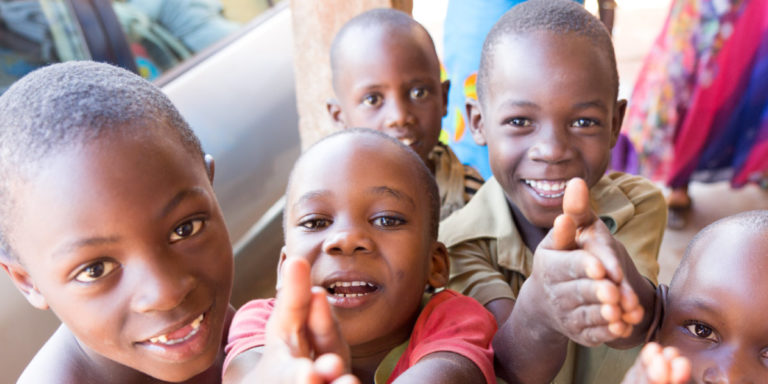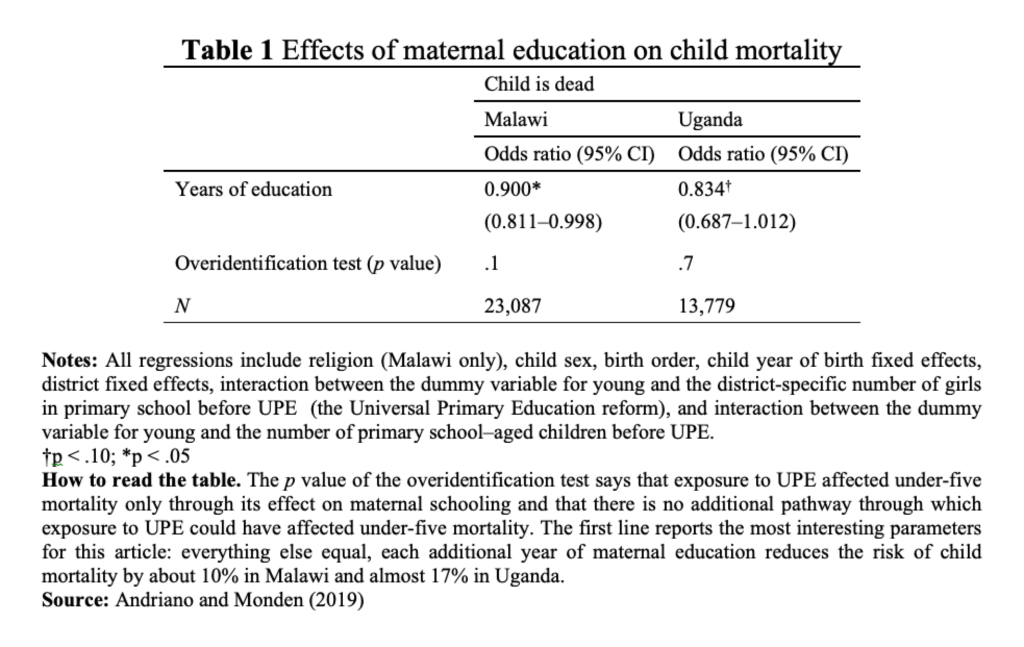Markedly lower child mortality in Malawi and Uganda with more educated mothers

Using data from Demographic and Health Surveys, Liliana Andriano and Christiaan Monden show that, everything else equal, each additional year of maternal schooling reduces children’s probability of dying before age 5 by about 10% in Malawi and by almost 17% in Uganda.
Child survival is a key indicator of social development and remains a serious challenge for developing countries. Although child mortality has decreased dramatically since 1990, more than 40 children per 1,000 live births died before their fifth birthday in 2016 (U.N. IGME 2017).
The demographic literature suggests that maternal schooling plays a key role in determining children’s chances of survival in low- and middle-income countries, and that increases in maternal education could account for more than 50% of the worldwide reduction in under-5 mortality between 1970 and 2009 (Gakidou et al. 2010). Despite the extensive literature on maternal education and child mortality, few studies have been able to assess by how much an increase in maternal education contributes to reducing child mortality because unobserved characteristics—such as maternal ability, family background and resources, and community infrastructure—may affect both variables. The effect of increased education on child mortality might thus be overestimated if it incorporates the effects of these unobserved characteristics. For example, girls with an advantaged family background tend to live in areas with (better) amenities and to have (greater) access to educational and medical facilities; this is likely to lead to an increase in their education and a decrease in the mortality of their children.
In a recent study (Andriano and Monden 2019), we investigate whether increased maternal schooling reduces children’s probability of dying before age 5 in Malawi and Uganda, building on the Universal Primary Education (UPE) reforms that were implemented in Malawi and Uganda in 1994 and 1997, respectively, and that mainly abolished tuition fees for all grades of primary school. The UPE reforms substantially improved enrolment in both countries. In Malawi, enrolment in primary education increased by 51% in the first year, from 1.9 million in 1993 to 2.9 million in 1994 (Al-Samarrai and Zaman 2002; Inoue and Oketch 2008). In Uganda, it jumped from 3.4 million in 1996 to 5.7 million in 1997: plus 68% in just one year, and plus 140% over six years (Avenstrup et al. 2004). Our study takes advantage of the timing of the UPE reforms to estimate the effect on child mortality of an “exogenous” change in maternal education.
Data
We use data from the Demographic and Health Surveys (DHS), national household sample surveys conducted in low- and middle-income countries, whose data are well suited to studying the effect of maternal education on child mortality. We have information on women’s educational attainment, as well as complete birth and (when applicable) death histories of their children. We also know their district of residence, so that by using district official statistics on education, we can build some of our key explanatory variables. Finally, we also have information on women’s contraceptive use, health knowledge, and position in the household; this allows us to shed light on the potential mechanisms underlying the impact of maternal education on child mortality. For Malawi, we use pooled data from the 2000, 2004, and 2010 DHS; for Uganda, we did the same with the DHS surveys of 2000–2001, 2006, 2011, and the 2009 DHS–Malaria Indicator Survey.
On average, women exposed to UPE had more education than non-exposed women and the mortality of their children under age 5 was lower than that of children born to non-exposed mothers. In Malawi, non-exposed women had about 3.5 years of education, and exposed women had about 5.5 years; and in Uganda, 4.5 and 6 years, respectively. The mortality of children under age 5 born to exposed and unexposed mothers was 9% and 11%, respectively, in Malawi; and 7% and 10%, respectively, in Uganda.
The causal effect of maternal education on child mortality
We use an instrumental variable approach to investigate whether increased maternal schooling causally reduces child mortality. Table 1 provides the results of this analysis. We find a negative effect of maternal education on child mortality in both countries. In Malawi, for each additional year of maternal education, children have a 10% lower probability of dying; in Uganda, the odds are 16.6% lower. These findings refer to the impact of an increase in the quantity—as opposed to quality—of education. While we recognize that the quality of education individuals receive might also play a role, the UPE policy was meant to increase the quantity of education and we demonstrate that greater access to school can indeed have positive implications for child survival.

Women’s education does more than “just” reduce child mortality
We distinguish six broad mechanisms that have been proposed as explanations for the effect of maternal education on child mortality. The DHS provide some (imperfect) measurements for these mechanisms. One additional year of schooling increases the DHS wealth index by 0.151 in Uganda, a sizeable effect given that the average wealth index is 1.2 (range: 0 to 3.9). Similarly, for each additional year of education, the probability of not considering money to be a barrier to medical care increases by 2.9% in Malawi and 7.5% in Uganda. These effects are particularly important given that in both countries, about 60% of women consider money to be a barrier to medical care.
A one-year increase in education increases the probability of using of modern contraceptive methods—a proxy of attitudes towards modern health care—by 2.8% in Malawi and 2.7% in Uganda, where respectively 42% and 27% of women use modern contraceptive methods. With regard to personal illness control, in Uganda, where the average level is 2.7 (range: 0 to 7.3), each additional year of education produces an increase of 0.079. For the environmental pathway, a one-year increase in education increases the probability of living close to a health facility by 3.1% in Malawi, where only about 41% of women live relatively close to a health facility.
Does education affect health knowledge? For each additional year of education, knowledge about the transmission of AIDS increases by 0.023 in Malawi, where the average is 2 (range: 0 to 2.5). Finally, we examine whether female empowerment is affected by schooling. A one-year increase in education leads to an increase in rejection of domestic violence of 0.1 in Malawi and 0.2 in Uganda. These are particularly sizeable effects given that the mean level of rejection of domestic violence is 3.2 in Malawi and 1.6 in Uganda (range: 0 to 3.7).
Conclusions
To conclude, we investigate the effect of maternal education on child mortality by taking advantage of educational reforms that introduced free primary education in Malawi and Uganda in 1994 and 1997, respectively. In both countries, the reform caused an increase in schooling. Our findings show that maternal education considerably reduces child mortality, and suggest that in other sub-Saharan countries which have more recently started to eliminate primary education fees as part of the UNESCO Education for All initiative, free primary education for girls could have similar implications for reducing child mortality.
References
Al-Samarrai, S., & Zaman, H. (2002). The Changing Distribution of Public Education Expenditure in Malawi (No. 29). Washington, DC: World Bank.
Andriano, L., & Monden, C. W. S. (2019). The causal effect of maternal education on child mortality: Evidence from a quasi-experiment in Malawi and Uganda. Demography, 56(5), 1765–1790.
Avenstrup, R., Liang, X., & Nellemann, S. (2004). Kenya, Lesotho, Malawi and Uganda: Universal Primary Education and Poverty Reduction (No. 30765). Washington, DC: World Bank.
Gakidou, E., Cowling, K., Lozano, R., & Murray, C. J. (2010). Increased educational attainment and its effect on child mortality in 175 countries between 1970 and 2009: a systematic analysis. The Lancet, 376(9745), 959–974.
Inoue, K., & Oketch, M. (2008). Implementing Free Primary Education Policy in Malawi and Ghana: Equity and Efficiency Analysis. Peabody Journal of Education, 83(1), 41–70.
UN IGME. (2017). Levels & Trends in Child Mortality: Report 2017, Estimates Developed by the UN Inter-agency Group for Child Mortality Estimation. New York, NY, USA: UNICEF.